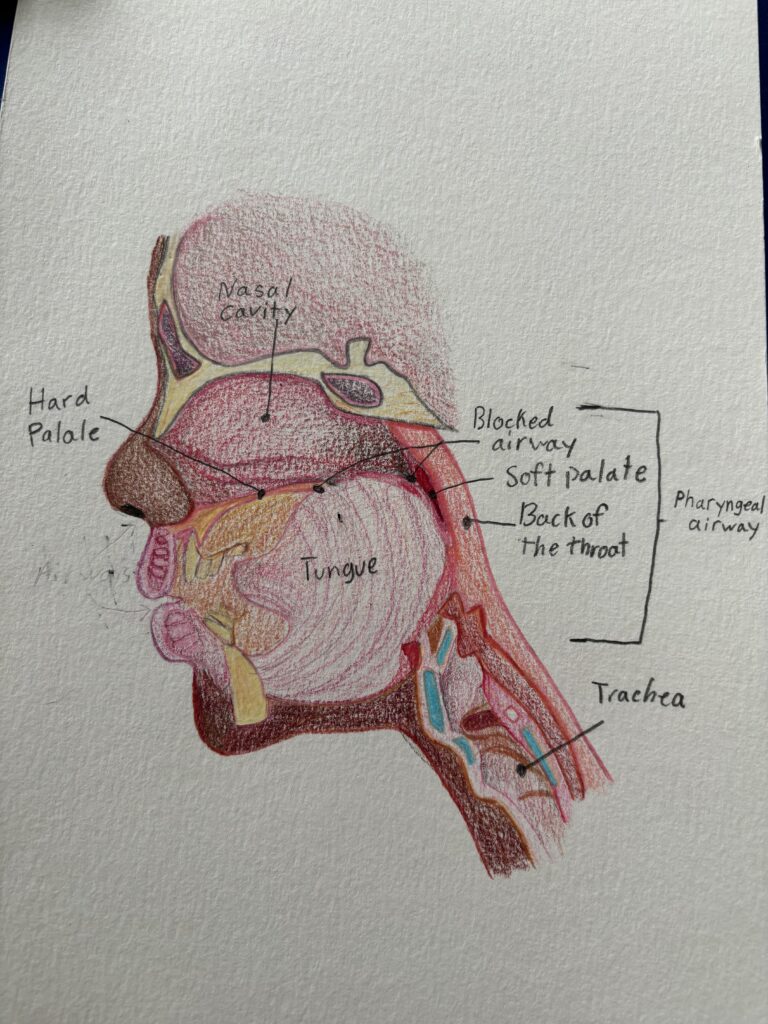
Sleep apnea is a chronic disorder that can occur in children or adults (Betts et al., 2022). The definition of apnea is a period when you stop breathing or have little airflow (Kondamudi, 2023). Sleep apnea is characterized by the cessation of breathing during sleep. These episodes may last for several seconds or several minutes and may differ in the frequency with which they are experienced (Betts et al., 2022). There are three types of sleep apnea: central, complex, and obstructive sleep apnea. This project focuses on obstructive sleep apnea through the medium of drawing. This drawing depicts a sleeping person and what physiologically happens while experiencing an episode of obstructive sleep apnea. I use this drawing to discuss what causes sleep apnea, its symptoms, and its risk factors.
Depicted in this drawing of a person sleeping are the pharyngeal airway, tongue, nasal cavity, soft palate, hard palate, back of the throat, and trachea. Obstructive sleep apnea is characterized by episodes of a complete collapse of the upper airway, causing an apnea or a partial collapse of the upper airways, causing hypopnea with an associated decrease in oxygen saturation or arousal from sleep (Slowik, 2024). Repetitive collapse of the pharyngeal or upper airways during sleep is a complex phenomenon, and multiple factors play a role in developing this disease.
The soft palate muscles support the back of the roof of the mouth. The muscles in the back of the throat also support the tongue and side walls of the throat. When the muscles relax, the airway narrows or closes as you breathe in. Obstructive sleep apnea occurs when the muscles in the back of the throat relax too much to allow for proper breathing (Obstructive sleep apnea 2023). This can lower the level of oxygen in the blood and cause a buildup of carbon dioxide. The brain senses this impaired breathing and briefly rouses a person from sleep so that they can reopen their airway (Obstructive sleep apnea 2023). This disturbance results in fragmented, non-restorative sleep (Slowik, 2024).
Fragmented sleep isn’t the only symptom of this condition. Symptoms of obstructive sleep apnea include loud, disruptive snoring, witnessed apneas during sleep, and excessive daytime sleepiness (Slowik, 2024). Additionally obstructive sleep apnea has significant implications for cardiovascular health which include ricks of hypertension, stroke, myocardial infarction, and heart failure and neurocognitive dysfunction such as excessive sleepiness and decreased quality of life (Betts et al., 2022).
In conclusion it is important to understand obstructive sleep apnea because it can severely affect the quality of life for individuals how experience this disorder. My drawing illustrates the anatomical structures impacted by an episode of obstructive sleep apnea. As a result of this project, I have learned about the physiological mechanisms, causes, and symptoms of this disorder
References
Betts, J., Desaix, P., Johnson, E., Johnson, J., Korol, O., Kruse, D., Poe, B., Wise, J., Womble, M., & Young, K. (2022). Anatomy and physiology, 2E. OpenStax, Rice University
Kondamudi, N. P. (2023, August 12). Apnea in children. StatPearls [Internet]. https://www.ncbi.nlm.nih.gov/books/NBK441894/
Slowik, J. M. (2024a, March 21). Obstructive sleep apnea. StatPearls [Internet]. https://www.ncbi.nlm.nih.gov/books/NBK459252/
Mayo Foundation for Medical Education and Research. (2023, July 14). Obstructive sleep apnea. Mayo Clinic. https://www.mayoclinic.org/diseases-conditions/obstructive-sleep-apnea/symptoms-causes/syc-20352090#:~:text=Obstructive%20sleep%20apnea%20occurs%20when,breathing%20is%20momentarily%20cut%20off.
.
